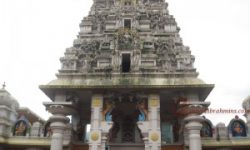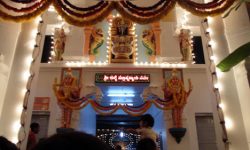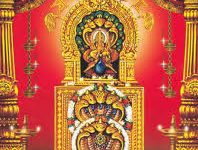Tag: aditi
56) SRI KRISHNA’S QUEENS
Continuing with the divine tales of Sri Krishna, Lord Mahadeva told Parvati–Sri Krishna had 16 thousand queens among whom Satyabhama, Kalindi, Mitravinda, etc. were prominent. King Sattajit had a priceless diamond named–Syamantak, which he had presented to his younger brother–Prasena. Sri Krishna was fascinated by that diamond and demanded it…
Exploring the Divine Tales of Vasudeva Krishna The Request of Parvati to Lord Mahadeva
Parvati requested Lord Mahadeva to narrate the divine tales of Vasudeva Krishna. Lord Mahadeva replied–Vasudev was the descendant of yadu. His father was Devameedha. He was married to Devaki–the daughter of Ugrasena.Ugrasena also had a mighty son named Kansa. Kansa was extremely affectionate towards his sister Devaki. After her marriage,…
47) VAMANA–INCARNATION
Continuing with the various incarnations of Lord Vishnu, Lord Mahadeva told Parvati — Prahlada had a son named Virochan.The most benevolent king–‘Mahabahu-Bali’ was Virochan’s son. Bali had defeated the deities and ruled over all the three worlds. Sage Kashyapa commenced the most austere penance–Payovrata to help the deities regain their lost…
45) THE INCARNATIONS OF MATSYA AND KURMA
Once, goddess Parvati expressed her desire to know about all the incarnations of Lord Vishnu. Lord Mahadeva replied– Lord Brahma had created numerous Prajapatis like Bhrigu, Marichi, Atri, Daksha, Kardam, Pulastya, Pulaha, Angira and Kratu. Marichi was the father of Kashyapa. Sage Kashyapa had four wives–Aditi, Diti, Kadru and Vinta.Aditi…
10) BASHKALI–THE DEMON KING
Bhisma requested Sage Pulastya to reveal Why Lord Vishnu had to take incarnation as Vamana. Sage Pulastya replied— Once, during Satya Yuga, the demons had defeated the deities and driven them out from their abode–heaven. The mighty demon, Bashkali was their leader. He had become immortal an account of a…
7) THE ORIGIN OF DEITIES, DEMONS and SERPENTS
Bhisma requested Sage Pulastya to explain how different entities like the deities, demons and serpents came into being. Pulastya replied—Having failed in his repeated attempts of increasing population by the means of ‘sankalpa’ Daksha Prajapati was left with no option but to take the help of copulative creation. He begot…
The Temples of Tirupati – Date of the temple
has already been made that the Vaishnava traditions ascribe its building to the great teacher, Ramanuja, about 1130A.D. This date falls within the period of Chola rule. The Chola capitals onthe pillars of the verandah round the main shrine and its mukhamantapa indicate this date: These pillars are similar to…
AVATAR MEANING -A concept meaning incarnation
The term avatara is usually associated with divine incarnations, especially the ten incarnations of Vishnu. But there were lists with as many as twenty-six incarnations. The ten avatars, dashavatara (dasha, “ten,” and avatara, “incarnations”), were Matsya the fish, Kurma the turtle, Varaha the boar, Narasimha the lion-man, Vamana the brahmacari…
ARJUNA, Arjuna Story in English – A hero and warrior
history of the tirumala- tirupati region – The Transitory period 1260-1360 A.D.
Tondamandalam was included in the Vijayanagara empire from the very time of its foundation in 1336 A.D. Still, the earliest Vijayanagara record found in the Tirumala-Tirupati region is dated 1359 A.D. The period intervening between the time of Sundara Pandya and this Vijayanagara record is a period of transition. During…
AGNI -A deva (god), god of fire, Agni puran
ADITYAS, Adityas Story in English – Devas (gods)

The sons born to Kasyapa-prajapati (a grandfather or procreator) and Aditi (mother of the gods) are called the adityas. In the hymns of the Rigveda, Aditi only had seven or eight children. But by the time of the Brahmanas there are twelve adityas: Dhata, Mitra, Aryaman, Rudra, Varuna, Surya, Bhaga,…
SHRI KSHETRA KUKKE SUBRAMANYA – Uttaradimath
ADITI -A devi (goddess), Mother of The Gods, Aditi devi story

There are few interesting myths to tell about Aditi, but her status and roles change so remarkably that she illustrates the fluidity of Hindu myths. Her name literally means eternity (free, boundless, infinity), so philosophically she is a personification of time. Aditi slowly evolved as the prototype of…
SHRI KSHETRA KUKKE SUBRAMANYA – A summary of the kourmarika Khanda as Depicted in Skanda Purana
Shri kshetra kukke subramanya temple

India is a holu place where there are follow-ers of different religions. Still there is unity amongthem. Our Culture is rich one. One can very wellunderstand the attitude of Indians through thesereligions. Even foreigners are also amazed to lookat this fantastic culture. Karnataka is 8th largest state in the nation….
2) CHAPTER TWO DESCRIPTION OF IKSHVAKU’S LINEAGE
Ikshvaku was born from the nostril of Manu as a result of sudden sneezing. Ikshvaku had hundred sons among whom Vikukshi, Nimi and Danda were prominent. Once Ikshvaku organised a Shradha. For the purpose of feeding Brahmins, he ordered his son Vikukshi to bring fresh meat of wild animals. Taking…
45) THE LINEAGE OF ADITYA
On being enquired by the Sages about the respective lineage of Aditya (Sun) and Soma (moon) Suta replied— Sage Kashyapa had a son–Aditya, from Aditi. Aditya had four wives–Sangya, Rajyi, Prabha and Chhaya. Sangya gave birth to Manu whereas Ragyi was the mother of Yama, Yamuna and Raivat. Prabha gave…
43) THE ORIGIN OF DEITIES
On being enquired by the sages about the origin of deities, demons and other celestial entities, Suta said– Daksha being desirous of enhancing the population, created ten-thousand sons merely by his wish and instructed them to contribute in the propagation of population. His objective remained unfulfilled as Narada was successful…
10) CHAPTER TEN CUSTOMS AND CONSECRATIONS
At the time of childbirth, it is the father’s responsibility to carry out certain customs and consecrations for the child. First of all, Jatakarma Sanskara is carried out by which the newly born baby is included in the family. During this custom, a Brahmin couple is fed. It is also…
12) CHAPTER TWELVE SANCTIFICATION AFTER BIRTH AND DEATH
Life on earth is like an infinite ocean in which birth appears like a bubble and death marks the bursting of that bubble after which it exists no more. Atmosphere of a household is said to be defiled when a birth or death occurs in it. There are different sanctifying…
11) CHAPTER ELEVEN DESCRIPTION OF RIGHTEOUSNESS
A married man knows the importance of following a righteous discourse. Married life is like a penance in which a couple gives birth and raises next generation. A married man is expected to get up early in the morning and contemplate on religious things. It helps him to follow righteous…
19) The Solar Dynasty
The sun-god, Vivasvana, was the son of Kashyapa and Aditi. He had four wives, Samjna, Rajni, Prabha and Chhaya. Samjna’s son was Vaivasvata Manu. Rajni’s children were Yama, yamuna and Revanta. Savarni, Shani, Tapati and Vishti were Chhaya’s children and Prabha’s son was Prabhata. (The names do not…
17) Bali
With Andhaka thus taken care of, Prahlada’s son Virochana became the king of the demons. He ruled his kingdom well. There was a sage named Sanatakumara who once went to visit Virochana. Virochana was delighted to see the sage and Sanatakumara instructed Virochana on the true nature of the…
12) Daksha’s Story
Daksha was Brahma’s son and had a daughter named Sati. Sati was married to Shiva. Daksha was thus Shiva’s father-in-law. Once Daksha came to visit his son-in-law. But although Shiva worshipped him with all due respect, Daksha felt that he had been slighted. Subsequently, when Sati went to visit…
10) Parvati’s Thousand Names
Shiva was married to Daksha’s daughter Sati. Sati died and was reborn as Parvati, the daughter of Himalaya and his wife Mena (alternatively, Menaka). Parvati was married to Shiva. In fact, Himalaya and Mena prayed so that they might have the goddess as their daughter. Pleased with their prayers,…
7) Creation continued
Brahma first created five sons through his mental powers. Their names were Sanaka, Sanatana, Sanandana, Kratu and Sanatakumara These five sons became sages and did not have any offspring. Brahma therefore had to create some more beings so that the population of the universe might increase. But prior to that,…
18) BRAHMA PURANA – Bali
There was a king of the daityas named Bali. He was powerful and invincible. He was also righteous and truthful. The gods cold not bear to see Bali’s prosperity and began to plot how Bali might be foiled. So well did Bali rule that disease, drought and evil disappeared throughout…
14) BRAHMA PURANA – Konaraka
There is an ocean to the south of Bharataavarsha. One the shores of this great ocean there is a land named Ondra or Utkala (present Orissa). Utkala is populated by religious people and the brahmanas who live there are learned in the Vedas. They are very good priests, learned in…
3) BRAHMA PURANA – Daksha’s Offspring
Daksha’s wife was named Asikli and Asikli gave birth to five thousand sons. They were known as the Haryashvas. The Haryashvas were destined to rule over the world. But the sage Narada went to the Haryashvas and said, “How can you rule over the world if you don’t even know…
ADITI GIVES BIRTH TO ADITYA
Markandeya says- ‘After being pleased by the eulogy of Aditi, the Sun shed its radiance and became sombre. Now, Aditi could see him. She said- ‘O lord! Be pleased upon me. The Daityas and the Danavas have captured all the three worlds from my sons. I request you to take…
MANIFESTATION OF THE SUN GOD ADITYA AND THE VEDAS
Markandeya says- ‘After Brahma came out from that egg, Rigveda manifested from his first mouth. From the mouth facing south, manifested the Yajurveda. After that, Samaveda manifested from his mouth facing west. In the end, Atharvaveda came out from the mouth facing north. The Rigveda symbolises the Rajo Guna while…
BIRTH OF MARTANDADEV
Lord Brahma had created Daksha from the thumb of his right hand. Daksha’s wife was created from the thumb of Brahma’s left hand. Daksha had a daughter named Aditi. Martandadev was the son of Aditi and his father was Kashyapa. Kraustuki asked- ‘O lord! Why did Vivasvan Surya took birth…
YOGA, YOGAS – A system of thought and practice
The word yoga is frequently used in Indian philosophy. It means “union” and connotes uniting the individual self with the higher Self. The Bhagavad Gita defined yoga as “skillfulness in action” and “steadiness of mind.” Yoga as a system of Indian thought was founded by Patanjali, probably of the second…
VEDAS – The Scripture

Veda means “knowledge,” but specifically refers to the eternal wisdom of the four collections of hymns, sacrificial rituals, andVayu, the wind, shown riding his vahana, the antelope other sacred texts that are called the Vedas. Along with the four collections (the Samhitas, the Brahmanas, the Aranyakas, and the Upanishads), two…
VAMANA – The fifth of the ten incarnations of Vishnu

Vamana was the dwarf incarnation (avatara) of Vishnu. The myth utilized the device of deceit, or outwitting the opponent, even though the struggle was between the supreme god Vishnu and a demon (asura) named Bali. Although an avatara was required to restore the proper order and return righteousness to…
TANTRA, tantra meaning – A religious sect or practice
Tantra has had many meanings: a class of literature (the Tantras), practices that are non-Vedic (tantrika), one of the religious sects of Hinduism. There is no single word in Sanskrit for Tantrism as a religious perspective, even though its additions to the Hindu tradition make it quite distinctive. Tantrism can…
TVASHTHRI – God of craftsmanship
Tvashthri, literally the shaper, was the son of Kasiyapa and Aditi. Alain Danielou called him the personification of one of the six minor principles of Vedic culture: craftsmanship. The hymns in the Rigveda made him function something like later concepts such as sakti (divine energy) and life force (prana), except…
UPANISHAD – A scripture from the last of the four divisions of the Vedas
The meaning of upanishad is “to sit near attentively.” They usually consisted of a metaphysical discussion between the sage and a disciple. There are 108 Upanishads traditionally, although only a dozen, the so-called major Upanishads, are in every list. Minor Upanishads are still being written. In the early Vedic period,…
SURYA, Surya Dev Mantra in English – The sun god
SUDDHI – A concept
The concept of purification (suddhi) is linked to pollution (mala) and the ways it is removed: ritually, physically, or even by divine grace. Central to the Vedic sacrifices was the notion that blood sacrifices would atone for wrong-doing and remove a form of purification called agnisuddhi. Siva was not invited…
SASTRAS – A set of law codes
The Sastras (precepts, rules) are a class of texts that cover religion as well as law, medicine, and the (pre-) science of that period. They were classified as tradition (smriti), ranking below the Vedas in sacredness. They have some mythological material, but it is their insight into the context of…
SARASWATI Mata mantra, Saraswati wife of Brahma- A goddess

Sarasvati is a goddess of primary importance. She is accepted by Hindus as the goddess of learning, the arts, and scholarship. However, Sarasvati’s nature is far more complex and her mythology more interesting than is widely known. Sarasvati, whose name means “flowing” and “watery,” has been associated with an ancient…
SAMNYASIN, SAMNYASA – The renunciate stage of life
The four life stages (asrama-dharma) are viewed by many scholars as joining the Vedic model of three life stages of the Aryas (“the noble ones,” who were twice- born) with a fourth stage, that of renunciation, which developed outside of the Aryan or Brahmanical tradition. The renunciation movement spanned such…
RUDRAS – A troublesome class of gods, storm gods
RUDRA, Lord Rudra Wife – A Vedic god; a tantric form of Siva

Rudra was a Vedic god (deva) long before (Siva would have been accepted as Brahmanical, or orthopraxic. However, the name Rudra was eventually appropriated for Siva, as a designation of a manifestation of Siva that was both dangerous and just within the boundaries of respectability. Even before this process was…
TALE OF HIRANYAKSH AND HIRANYKASHIPU
By the curse of Brahmins, the gatekeepers of the God, Jay-Vijay took their first birth as the demons- Hiranyakashipu and Hiranyaksh. Diti was their mother. Hiranyaksh had stolen the earth and hidden it in Sutala Loka, causing worries for Brahma. To remove the worries of Brahma, Lord appeared as Varaha…








